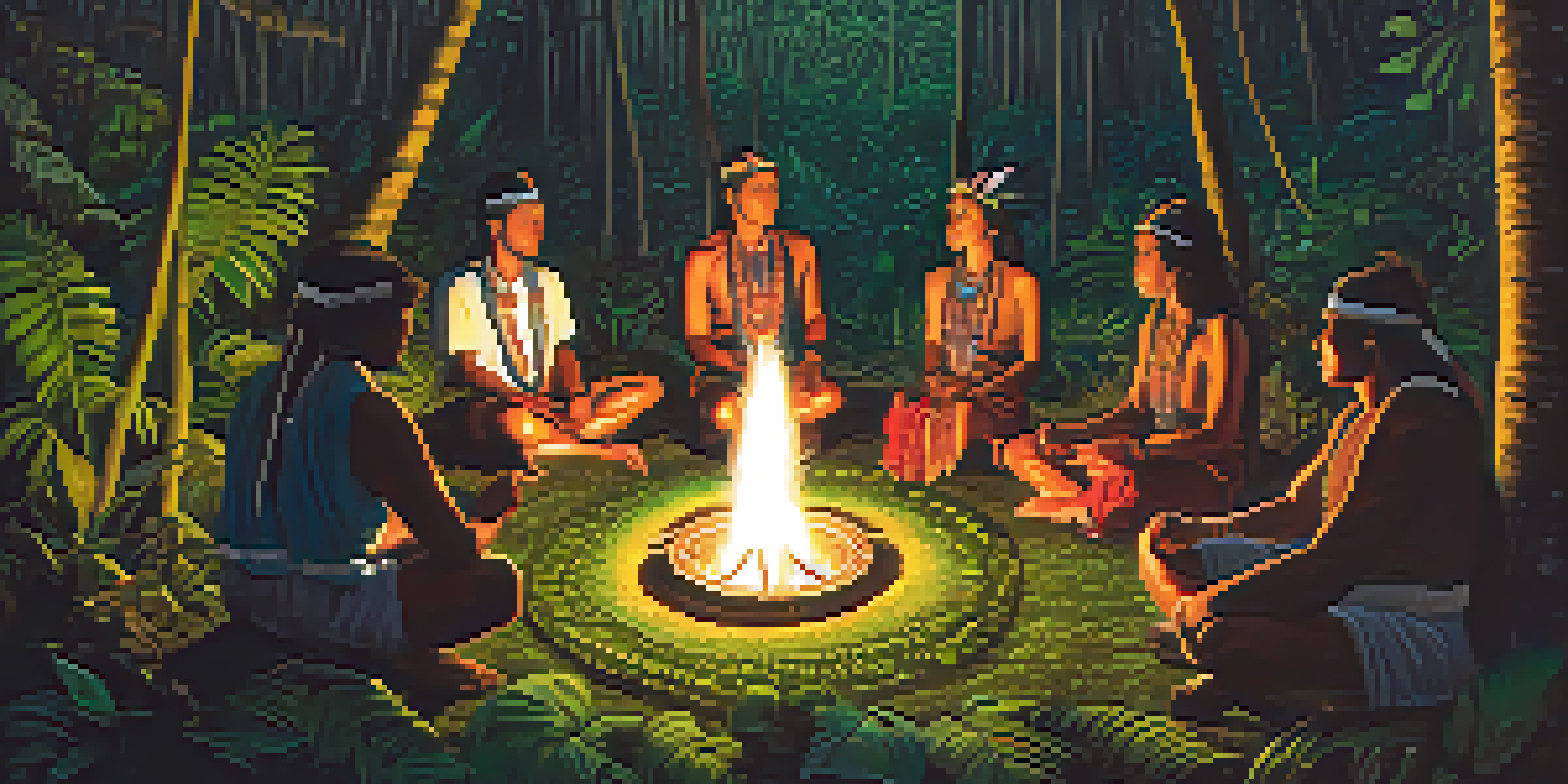Ritualistic Use of Ayahuasca: A Historical Perspective

Understanding Ayahuasca: Origins and Composition
Ayahuasca is a powerful brew made from the Banisteriopsis caapi vine and other plants, often containing DMT, a potent psychoactive compound. This concoction has been used for centuries, primarily by indigenous tribes in the Amazon rainforest. The combination of these plants creates a unique experience that many believe connects them with the spiritual world.
Ayahuasca is a tool for spiritual awakening; it reveals the connections we share with each other and the universe.
The origins of ayahuasca can be traced back thousands of years, with some estimates suggesting its use began around 1000 BCE. Indigenous peoples, including the Shipibo and Ashaninka, have long revered ayahuasca for its healing and spiritual properties. The ritualistic use of ayahuasca often serves as a bridge between the physical and spiritual realms, enabling participants to explore their consciousness.
Today, ayahuasca has gained international attention, attracting individuals seeking personal growth, healing, and spiritual insights. However, understanding its historical context is crucial for practicing it responsibly and respectfully. The cultural significance of ayahuasca rituals underscores the importance of preserving indigenous practices and knowledge.
The Role of Shamans in Ayahuasca Rituals
Central to ayahuasca ceremonies are shamans, or 'curanderos,' who guide participants through their journeys. These individuals are often seen as spiritual leaders, possessing extensive knowledge of the plants and the rituals surrounding their use. Their role is not only to prepare the brew but also to create a safe and sacred space for healing and exploration.

Shamans utilize a variety of techniques, including singing icaros (sacred songs) and engaging in traditional rituals to facilitate the experience. Their presence helps participants navigate the often intense emotional and psychological landscapes that ayahuasca can unveil. This guidance is crucial, as the journey can be both enlightening and challenging.
Ayahuasca's Cultural Significance
Ayahuasca is deeply rooted in indigenous traditions, serving as a vital tool for healing and spiritual connection.
Furthermore, the relationship between the shaman and the participants is built on trust and respect. Shamans often spend years honing their craft, learning about the plants, and understanding the complexities of the human psyche. This deep-rooted knowledge underscores the importance of engaging with ayahuasca in a culturally respectful manner.
Ayahuasca and Spiritual Awakening: A Cultural Perspective
For many indigenous cultures, ayahuasca is viewed as a tool for spiritual awakening and personal transformation. The experiences often lead participants to confront their fears, traumas, and the deeper questions of existence. This transformative aspect is a significant reason why ayahuasca rituals are deeply embedded in the cultural fabric of these communities.
We must approach ayahuasca with respect and understanding, honoring its roots and the cultures that have preserved its wisdom.
In these ceremonies, participants often report profound insights and a sense of interconnectedness with the universe. This connection can foster a greater appreciation for nature and a sense of responsibility towards the environment. Such experiences highlight the holistic worldview held by many indigenous peoples, where spirituality and ecology are intertwined.
Moreover, this spiritual awakening is not just an individual journey; it often fosters communal healing. Participants frequently leave the ceremonies with a renewed sense of purpose and connection to their community. This collective aspect of healing reinforces the importance of ayahuasca rituals in preserving cultural identity and promoting unity.
Ritual Structure: The Ceremony's Framework
Ayahuasca ceremonies typically follow a structured framework that enhances the experience. These rituals often take place at night, in a dimly lit setting designed to promote introspection and connection. Participants usually gather in a circle, creating a sense of community and shared intention.
Before consuming ayahuasca, participants often engage in preparatory rituals, which may include prayers, intentions, or even fasting. These practices help to set the stage for the journey ahead, allowing participants to focus on their intentions. Once the brew is ingested, the ceremony unfolds in a unique and personal manner for each individual.
Shamans Guide the Experience
Shamans play a crucial role in ayahuasca ceremonies, providing guidance and creating a safe environment for participants.
Throughout the night, the shaman facilitates the experience, guiding participants through various stages of the journey. The use of music, chanting, and even healing techniques helps to maintain a supportive environment. This structured approach ensures that participants feel safe and held as they navigate the often intense emotional landscapes of their experiences.
Healing Properties: Ayahuasca's Therapeutic Benefits
Ayahuasca has garnered attention in recent years for its potential therapeutic benefits, particularly in treating mental health issues like depression and PTSD. Many participants report significant emotional healing and insights into their mental health struggles. This has led to an increasing interest in ayahuasca within therapeutic contexts, bridging traditional practices with modern psychology.
Research has shown that the compounds in ayahuasca can stimulate neurogenesis, potentially promoting brain health and emotional resilience. These findings have spurred a greater understanding of how traditional plant medicines can complement contemporary therapeutic approaches. However, it is essential to approach these treatments with caution and respect for their cultural origins.
Moreover, the healing benefits extend beyond individual experiences; many participants report improved relationships and a deeper connection to their communities. This communal aspect of healing emphasizes the importance of support and shared experiences in the therapeutic process. As such, the ayahuasca experience can serve as a catalyst for both personal and collective healing.
Cultural Appropriation vs. Appreciation in Ayahuasca Use
As ayahuasca gains popularity in the West, discussions around cultural appropriation versus appreciation have emerged. It's crucial to recognize that this sacred practice stems from indigenous cultures that have preserved its rituals for generations. Appropriating these traditions without understanding their context can be harmful and disrespectful.
Appreciation, on the other hand, involves respecting and honoring the cultural significance of ayahuasca while engaging with it responsibly. This means seeking out authentic experiences led by indigenous shamans and understanding the history behind the practices. Acknowledging the roots of ayahuasca can foster a deeper connection to the experience and its potential benefits.
Therapeutic Benefits Explored
Recent research highlights ayahuasca's potential therapeutic effects, particularly in addressing mental health challenges.
Balancing the line between appropriation and appreciation is essential for fostering respectful relationships with indigenous cultures. Engaging with ayahuasca in a way that honors its origins can lead to transformative experiences that are grounded in respect and understanding. This approach not only benefits participants but also supports the preservation of traditional practices.
The Future of Ayahuasca Rituals: Evolving Perspectives
As awareness of ayahuasca grows, so do the conversations about its future and the preservation of its rituals. There's an increasing push for sustainable practices that respect the plants and the indigenous communities that use them. This shift highlights the need for ethical considerations in the commercialization of ayahuasca retreats and ceremonies.
Many advocates are calling for a return to traditional practices, emphasizing the importance of community involvement and education. This approach ensures that the spiritual and cultural significance of ayahuasca is preserved for future generations. By prioritizing these values, we can foster a more respectful relationship with this powerful brew.

Moreover, the future of ayahuasca rituals may also involve scientific exploration and integration into modern therapeutic practices. As researchers continue to uncover its potential benefits, the dialogue surrounding ayahuasca can evolve to include both traditional and contemporary perspectives. This balance can pave the way for a more comprehensive understanding of ayahuasca and its place in both indigenous and global contexts.